The world of the Counselor An introduction to the counseling profession 5e chapter 2
Bạn đang xem bản rút gọn của tài liệu. Xem và tải ngay bản đầy đủ của tài liệu tại đây (810.96 KB, 28 trang )
The Counseling Profession’s
Past, Present and Future
© 2007 Thomson Brooks/Cole, a division of Thomson Learning
1
Since dawn of existence, people have attempted to
understand the human condition
Shamans
Egyptian papyrus (3330BCE)—attempt to understand functions
of the brain
Early philosophers
Hippocrates (460-377BCE): Offered suggestions for
treatment of human condition: for melancholia he
recommended sobriety, a regular and tranquil life,
exercise short of fatigue, and bleeding, if necessary. For
hysteria, he recommended getting married!
© 2007 Thomson Brooks/Cole, a division of Thomson Learning
2
Early philosophers (cont’d)
Monotheistic religions: Old Testament, New Testament,
Quran, and other religious text speak to how to “treat”
suffering
Plotinus (205-270): Soul separate from the body (dualistic
understanding of mind and body)
Descartes (1596-1650) and James Mill (1773-1836): Mind a
blank slate upon which ideas become generated.
© 2007 Thomson Brooks/Cole, a division of Thomson Learning
3
These three professions originated in the 19th century and
all impacted on the counseling field
Over the years, they have maintained their unique
identities, but have all moved to many of the same
theoretical conclusions.
Today, they, along with the counseling profession, can be
seen on slightly different, yet parallel paths
See Figure 2.1, p. 35
© 2007 Thomson Brooks/Cole, a division of Thomson Learning
4
HISTORICAL BACKGROUND
HISTORICAL BACKGROUND
Poor Laws (1500s)
Charity Organization
▪ “Friendly visitors”
Societies (COSs)
Settlement movement
▪ Jane Addams/Hull House
All of above led to social
casework, group work,
community, first social
work programs
© 2007 Thomson Brooks/Cole, a division of Thomson Learning
1940s-1950s: focus on
family and social systems
e.g., Virginia Satir
1955: NASW
1965 ACSW
Today, social workers
found in a wide variety of
settings
5
Systems: Family and social systems perspective has become
required focus by CACREP
Field experience: Practicum, Internship, and other “field
experiences” today seen as critical in counseling programs
Advocacy and Social Justice: Social work’s focus on advocacy
and social justice has become an important ingredient for the
counseling profession
© 2007 Thomson Brooks/Cole, a division of Thomson Learning
6
Historical Background (Early Basis of Psychology)
• Greek philosophers
• Hippocrates: Focused on how to treat mental illness
• Plato (427-347BCE): Introspection and reflection—road to knowledge;
dreams and fantasies—substitute satisfactions; human condition:
physical, moral and spiritual origins
• Aristotle (384-322BCE): Considered “first psychologist” used
objectivity and reason to study knowledge
• Augustine (354-430) and Aquinas (1225-1274): highlighted
consciousness, self-examination, and inquiry
• Focus on Christianity during Augustine and Aquinas times limited the
psychological nature of people
© 2007 Thomson Brooks/Cole, a division of Thomson Learning
7
Historical Background (1800s)
• Europe: First experimental psychologists studied similarities
and differences of people
• E.g.,: Wundt and Galton
• 1800s in U.S.: experimental psychologists
• James Cattell & G. Stanley Hall (1st president of APA)
• Williams James’ theory of philosophical pragmatism: truth
and reality is continually constructed
• Testing: Binet, vocational assessment, personality tests
• Mesmer (mesmerize), Charcot (hypnosis)
• Psychoanalysis and Freud
© 2007 Thomson Brooks/Cole, a division of Thomson Learning
8
Historical Background (late 1800s to 1900s)
• 1892: APA
• Other schools arise:
• Pavlov (classical conditioning); Phenomenology
psychology; Existentialism psychology; Gestalt
psychology
• Above schools led to today’s cognitive-behavioral and
existential-humanistic therapies
• Mid 1940’s: Division 17 (counseling psychology)
• Today: experimental psychologists, clinical and counseling
psychologists, school psychologists, psychologists in
business and industrial organizations
© 2007 Thomson Brooks/Cole, a division of Thomson Learning
9
Probably influenced counseling most of all professions
Gave us the first comprehensive approaches to counseling
and therapy
Tests developed by psychologist used by early vocational
counselors and other counselors today
Research techniques
Early development of counseling skills
© 2007 Thomson Brooks/Cole, a division of Thomson Learning
10
Historical Background
• Mental illness originally: mystical, demonic--treatment
horrific
• Pinel (late 1700s): Founder of psychiatry; one of first to view
mental illness from a scientific perspective
• Other well known psychiatrists:
• Kraepelin (early classification system)
• Charcot and Janet: relationship between disorders and
the mind
• Rush and Dix: Advocated for humane treatment of mentally
ill (see Box 2.1, p. 40)
• Assoc. of Medical Superintendents of Am. Institutions for
Insane—Forerunner of APA (1844)
© 2007 Thomson Brooks/Cole, a division of Thomson Learning
11
Historical Background
• Early 1900s: Many psychiatrists into psychoanalysis,
some move toward psychobiology, some toward social
psychiatry
• 1950s and 1960s: Expansion of psychotropics
• 1950s: DSM-I, Today DSM-IV-TR; 2013: DSM-5
• 1960s: Psychiatrists needed to work in Community Based
Mental Health Centers after “Donaldson v. O’Connor)
• Today: Mental illness predominantly or partially
biological
• Today: Psychiatrists often consult with counselors
© 2007 Thomson Brooks/Cole, a division of Thomson Learning
12
• Diagnosis
• Illnesses may be organic
• Psychopharmacology
© 2007 Thomson Brooks/Cole, a division of Thomson Learning
13
Precursors to the Counseling Profession: The 1800s
Read quote, top of p. 41
Beginning of Counseling Influenced by:
Social Reform Movement of the 1800s
▪ John Dewey writings in education
▪ More humane treatment of the mentally ill
▪ Social Workers who worked with poor and destitute
© 2007 Thomson Brooks/Cole, a division of Thomson Learning
14
Beginning of Counseling Movement Influenced by:
Need for Vocational Guidance in the late 1800s
▪ Traced all the way back to: Sanchez de Arevalo (1468)-Mirror of Men’s Lives
Testing
▪ Binet Intelligence test
▪ Group tests (e.g., special and multiple aptitude testing)
▪ Others
Psychoanalysis and Psychotherapy: Turn of 20th Century
▪ Offered a “psychological view” of people
© 2007 Thomson Brooks/Cole, a division of Thomson Learning
15
Vocational Guidance Movement—early 1900s
Jesse Davis, Anna Reed, Eli Weaver
Frank Parsons and Spread of Vocational Guidance
▪ Influenced by Jane Addams
▪ Man with a vision—”Founder” of guidance in America
▪ Vocational Guidance: 3-part process, see top of p. 44
▪ Established Vocational Bureau
▪ Led to establishment of NVGA
John Brewer
Wagner-O’Day Act
“Vocational” & “Guidance” counselors are first counselors
© 2007 Thomson Brooks/Cole, a division of Thomson Learning
16
Counseling and Expansion of Testing Movement (1900-1950)
Army Alpha (see Box 2.2, p. 45)
Strong Interest Inventory
Woodworth’s Personal Data Sheet
Group testing and vocational guidance
Some tests used in vocational guidance, other tests later
used in school and agency counseling
© 2007 Thomson Brooks/Cole, a division of Thomson Learning
17
Spread of Psychotherapy--Impact on Counseling (1900-1950)
Clifford Beers: A Mind that Found Itself:
▪ Congress passed laws to improve mental hospitals
End of WWI, doughboys, PTSD
▪ Need for more helpers
E. G. Williamson’s Minnesota Point of View (trait and factory
theory)
Humanists fleeing Europe
Carl Rogers and Rochester Guidance Clinic
All of the above influenced the burgeoning counseling field as
counselors moved from schools into other areas
© 2007 Thomson Brooks/Cole, a division of Thomson Learning
18
The 1950s: Emergence, Expansion, and Diversification
Carl Rogers and Client-Centered Therapy
Developmental theories of counseling arise: career
counseling, child development, lifespan development Sputnik
and NDEA
End of WWII and college counseling
1945: AAMFC—later AAMFT
1950s: NASW
Division 17 of APA
APGA
▪ ASCA, ACES, ACDA, ARCA, C-AHEAD
© 2007 Thomson Brooks/Cole, a division of Thomson Learning
19
1960s: Increased Diversification
Ellis
Behavioral: Bandura, Wolpe, Krumboltz
Glasser’s Reality Therapy
Gestalt: Perls
Existential: Arbuckle, Frankl, May
Expansion of services: Johnson’s Great Society
Community Mental Health Centers Act of 1963
NDEA expanded
Other federal acts
APGA’s 1961 1st ethical code
Precursors of CACREP
More ACA divisions and branches: NECA, AACE, State branches
© 2007 Thomson Brooks/Cole, a division of Thomson Learning
20
Continued Proliferation: 1970s
Donaldson v. O’Connor (see Box 2.3, p. 44)
Expansion of Community Mental Health Centers Act (12 services)
Rehabilitation Act
PL 94-142
Microcounseling skills training
Multicultural Counseling: Sue, Pedersen, Cross, Atkinson
ACES draft of standards for counseling programs
CORE
NACMHC
Virginia: First state to have licensing
New Divisions: AMCD, ASERVIC, ASGW, IAAOC, AMHCA
© 2007 Thomson Brooks/Cole, a division of Thomson Learning
21
1980s-2000: Recent Changes
CACREP (1981)
NBCC started NCC (1982)
IAMFC: certification for family therapists (1994)
Increased focus on multicultural issues
AMCD: Multicultural Counseling Competencies (1991)
Focus on: ethics, supervision, teaching, & online counseling
ACPA disaffiliates
AMHCA and ASCA threaten disaffiliation
APGA becomes AACD (1983) then ACA (1992)
New divisions: ACEG, AADA, IAMFC ACCA, AGLBIC, CSJ
© 2007 Thomson Brooks/Cole, a division of Thomson Learning
22
The New Millennium: 2000 and On
Expansion of NCC
▪ Over 45,000 NCCs
▪ Specialty certifications in: Clinical mental health
counseling, school counseling, addictions counseling
Licensing in all 50 states, Puerto Rico, and DC
Divisions become increasingly independent (not separate)
of ACA
ASCA National Model
New divisions: ACC and CSJ
Importance of Evidence-Based Practice
© 2007 Thomson Brooks/Cole, a division of Thomson Learning
23
The New Millennium: 2000 and On (Cont’d)
Multicultural Counseling know considered “fourth force”
Focus on Social Justice Advocacy
▪ 2003: ACA endorses Advocacy Competencies
▪ Fifth Force?
Focus on Crisis, Disaster, and Trauma Training
2005: New Ethics Code
2010: 20/20 Standards (see bottom of p. 54)
© 2007 Thomson Brooks/Cole, a division of Thomson Learning
24
We are what we are because of our past.
Why not strive to understand from whence we came, and
attempt to make smart, conscious choices about our future.
It’s not easy taking a hard look at oneself, and it is difficult
memorizing all those names!
See Table 2.1, pp. 56-58
© 2007 Thomson Brooks/Cole, a division of Thomson Learning
25









